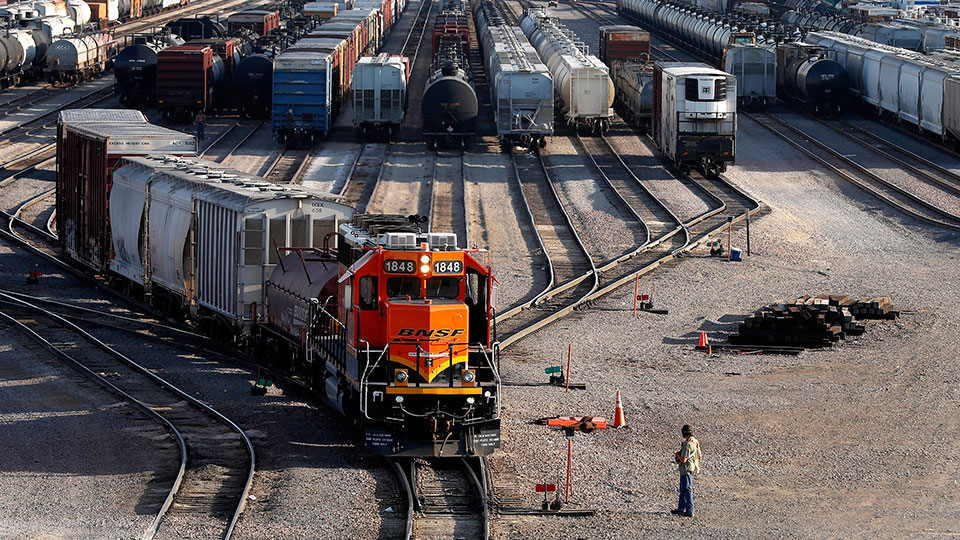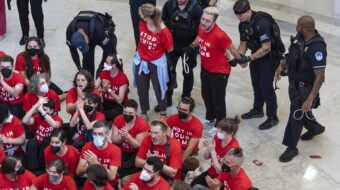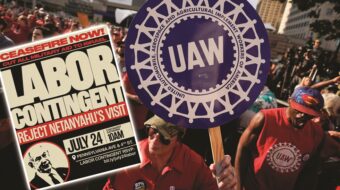
WASHINGTON—Working conditions, and labor-management negotiations between the unions representing the nation’s freight rail workers and railroad bosses, are getting steadily worse, reports from the bargaining table and congressional testimony show.
And that’s important because the nation’s four big Class I freight railroads move bulk cargoes from oil to cars to coal to corn and are a vital part of the U.S. supply chain.
But with talks having broken down, potentially forcing Democratic President Joe Biden to step in, and with safety conditions deteriorating as the carriers cut crew sizes in favor of “precision scheduled railroading (PSR)” and other money-saving profit-making tactics, the workers and the flow of supplies via rail are both in danger of breakdown.
“The railroad business model and increased pressures from management have created a ticking time bomb on our nation’s rails,” warned Don Grissom of the Transportation Communications Union, a Machinists sector.
The more immediate problem is the progress, or lack of it, in bargaining.
Key issues are erratic scheduling, safety and health, and the carriers’ insistence that they can run big long freight trains with only the engineer. That’s despite evidence showing the presence of a second worker, the conductor, is an extremely effective safety measure. Twelve of the nation’s 14 rail unions are in a joint coalition, with two others bargaining alongside them but separately.
And executives at one big carrier, Burlington Northern Santa Fe, advocated workerless trains at a conference in Chicago several years ago. That stand brought members of Railroad Workers United, a rank-and-file group with members of all railroad crafts, out to the streets for informational picketing about the hazard.
The union presidents said on June 15 that the carriers have been so intransigent that three weeks of compulsory mediation, run by the National Mediation Board—which oversees rail and air labor-management relations—went nowhere. That led NMB to offer compulsory arbitration to both sides, but it gave them only until 5 pm on June 16 to say “yes” or “no.”
Workers’ distrust of carriers’ corporate honchos is so high the unions had to say “no.” That triggered a 30-day “cooling-off period,” which ends July 18, NMB said. During it, Biden can appoint a Presidential Emergency Board to hold hearings and craft and recommend a solution. NMB has also scheduled “public interest meetings” on the dispute starting July 12. Ironically, the board’s notice says those meetings “are not open to the public.”
If that board makes recommendations, and either side rejects them, or if the board can’t come to a conclusion, there’s a second 30-day cooling-off period before the rail workers can strike and before the railroads can lock them out.
“If this happens, it is expected Congress will intervene and end self-help by passing legislation to resolve the dispute,” the rail union presidents said in their latest update.
“To address this possibility, we have already mobilized our legislative departments to get the message to our elected representatives. In addition to these efforts, we are urging our members to begin reaching out to their senators and representatives to voice their support for a labor-friendly PEB, and if necessary, labor-friendly legislation to bring this round of bargaining to a successful conclusion. (Their emphasis).
“The time to make our collective voices heard is now!”
But the rail unions already made their voices heard on Capitol Hill when it comes to working conditions and safety—and that’s a larger and longer-term problem. And its reason, the union leaders said, can be summed up in two words: Corporate greed.
The leader of the largest rail union, Jeremy Ferguson of Smart’s Transportation Division—the old United Transportation Union—even left the AFL-CIO Convention in Philadelphia to testify at the House Railroads and Hazardous Materials Subcommittee session on June 14.
“Despite all of the technology and modern-day advancements, the functionality of rail equipment is still crude, the hours are still relentless, and the work environment is still unsafe,” Ferguson told lawmakers.
“Granted, some progress was made over the years, but much, if not most, has been undone with the adoption of a business model called Precision Scheduled Railroading (PSR) which has left the state of railroad safety today in shambles.”
Ferguson blamed the Republican Trump regime for giving the railroads “excessive freedom to forego safety requirements to achieve their PSR-driven goals and to satisfy the pressures from their Wall Street investors.”
“PSR has led to the railroads significantly reducing service and reducing employment. This in turn lessened the number of required inspections, as well as the quality of inspections.”
PSR allows the one-worker crews railroads agitate for and the unions oppose. Several key states, notably Illinois and Nevada, now mandate two-person crews within their borders.
The other union leaders added details to Ferguson’s points. “Even as (freight) traffic has returned, staffing has not,” Brotherhood of Maintenance of Way Employees/Teamsters Safety Director Roy Morrison testified. The four Class I freight railroads had 153,000 workers in 2016, just after PSR was introduced. They had 123,000 in 2020, and 114,499 last year, he said.
But after an initial crash due to the coronavirus pandemic, freight traffic has rebounded, Morrison said. “By December of 2021, a workforce 81% of the size of the 2019 workforce was responsible for moving 97.4% of 2019 carloadings.
“Along with these staffing cuts, railroads have curtailed inspection, maintenance, and repair work on their infrastructure and equipment, and required a reduced workforce to handle the responsibilities once handled by a significantly larger workforce. The railroads have made it difficult to impossible for their employees to properly perform their tasks that are essential to adequate rail service.”
Carmen Assistant General President Grissom listed where jobs have been cut, rail yard by rail yard, on the Union Pacific and the Kansas City Southern. In some yards, such as St. Louis, there aren’t any carmen at all, leaving the train crews—who are untrained in inspections—to do the job. And 20 carmen were cut from the 18th Street yard in Kansas City, Ks.
That’s dangerous because carmen must inspect and certify a rail freight car is safe to roll before it can leave the yard. Cut the numbers of carmen, and cars go uninspected. And though each car has 160 key points of inspection—80 per side—inspections are supposed to take one minute for each incoming freight car and 1.7 minutes for each departing car.
“We’ve lost 15%-30% of our craft” since 2016, Grissom said. “PSR means doing less with less (people).”
Grissom also faulted the Federal Railroad Administration, which oversees the railroads and especially rail safety, for lax oversight for a very simple reason: FRA notifies the carriers four days in advance that it’s going to inspect a yard. And then its probers often go to side yards, directed there by local managers, not main yards. Worse, they don’t talk to workers.
“One would think if the FRA field inspectors are interested in mechanical safety, they would spend time talking to the folks on the ground that inspect for safety compliance,” said Grissom.












Comments